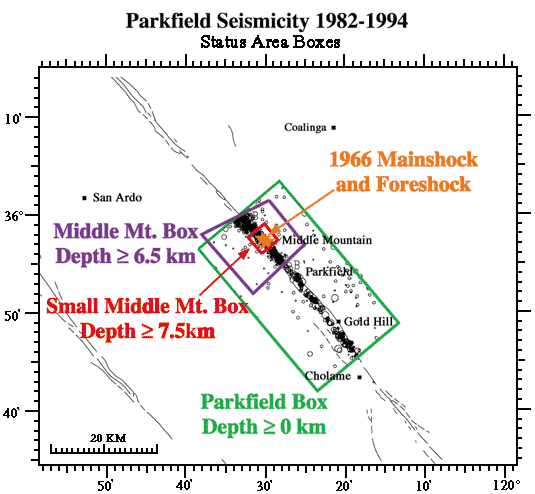| Status Level | Required Creep* (in absence of M 3.5 or larger shocks) | Required Seismicity* | 1996 Probability, in %, of shocks in next 72 hours+ |
|---|---|---|---|
| D | At any one site other than XSCI1,
a nearly continuous increase in creep that exceeds 1 mm within 7 days
and continues at a comparable or greater rate over a period greater
than 10 days. At any two adjacent sites other than XSCI, nearly simultaneous onset of an almost continuous increase in creep that exceeds 0.5 mm in 24 hours. At one site, an unusually large creep event. For creep meters northwest f XDR2 events with creep >0.5 mm in the first 30 minutes would be unusually large. For creepmeters southeast of XDR2 events with creep >0.33 mm in the first 30 minutes would be unusually large. At any one site, a series of closely spaced creep events, with continuous movement greater than 1.5 mm in 3 hours. |
One M> or = 3.2 shocks in the Small Middle
Mt. alert zone
One M 3.3 shocks in the Parkfield alert zone |
0.68 |
| C | Nearly simultaneously onset of creep at two or more creepmeters that exceeds 0.5 mm in one hour. More than 1 mm of creep on the Middle Mtn. creepmeter in one hour. |
One M> or = 3.9 shocks in the Small Middle Mt. alert zone
One M 4.2 shocks in the Parkfield alert zone |
2.8 |
| B | More than 5 mm of creep in 72 hours on the Middle Mtn. creepmeter with confirming signals of tectonic origin on another network. More than 5 mm of creep in 72 hours on two or more parkfield area creepemeters. |
One M> or = 4.7 shocks in the Small Middle Mt. alert zone One M 5.2 shock in the Parkfield alert zone |
11 |
| A | Creep rates on multiple instrument (or at Middle Mtn. along with confirming signals of tectonic origin on another network) in excess of 0.5 mm/hour for 6-10 hours or cumulative creep in excess of 5 mm in a shorter period. | Recurrence of the immediate M 5 foreshock to the 1934 and 1966 Parkfield mainshocks, as determined by special studies of its seismic waveforms and hypocentral location | 37 |
* The status levels get down-graded if it has been raining in the week prior to the candidate creep event unless signals can be confirmed with additional data. Either seismicity or creep can meet the spcific status criteria. If both creep and seismicity meet their specifed criteria for a status level, then the status level is increased to the next level. (ie, If both seismicity and creep meet status level "C", the level is increased to a status level "B".) There are other instruments that have athreshold for status level D.
+ Seismicity status probabilities are based on statistical models of foreshock behavior. For the other networks (such as creep) probabilities are based on anomalies about as unusual as the stated earthquakes, but the data are insufficient to support a formal statistical analysis.


 Jump to Navigation
Jump to Navigation